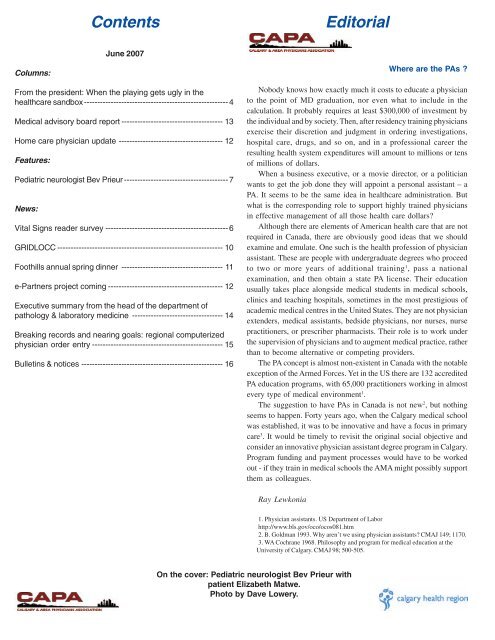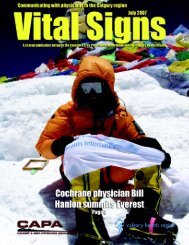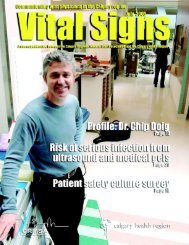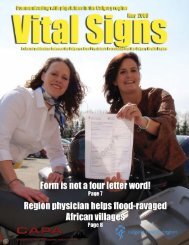CHR.ps, page 1-16 @ Normalize - Calgary & Area Physician's ...
CHR.ps, page 1-16 @ Normalize - Calgary & Area Physician's ...
CHR.ps, page 1-16 @ Normalize - Calgary & Area Physician's ...
You also want an ePaper? Increase the reach of your titles
YUMPU automatically turns print PDFs into web optimized ePapers that Google loves.
Columns:<br />
June 2007<br />
From the president: When the playing gets ugly in the<br />
healthcare sandbox ------------------------------------------------------ 4<br />
Medical advisory board report -------------------------------------- 13<br />
Home care physician update --------------------------------------- 12<br />
Features:<br />
Pediatric neurologist Bev Prieur --------------------------------------- 7<br />
News:<br />
Contents<br />
Vital Signs reader survey ---------------------------------------------- 6<br />
GRIDLOCC -------------------------------------------------------------- 10<br />
Foothills annual spring dinner -------------------------------------- 11<br />
e-Partners project coming ------------------------------------------- 12<br />
Executive summary from the head of the department of<br />
pathology & laboratory medicine ---------------------------------- 14<br />
Breaking records and nearing goals: regional computerized<br />
physician order entry ------------------------------------------------- 15<br />
Bulletins & notices ----------------------------------------------------- <strong>16</strong><br />
On the cover: Pediatric neurologist Bev Prieur with<br />
patient Elizabeth Matwe.<br />
Photo by Dave Lowery.<br />
Editorial<br />
Where are the PAs ?<br />
Nobody knows how exactly much it costs to educate a physician<br />
to the point of MD graduation, nor even what to include in the<br />
calculation. It probably requires at least $300,000 of investment by<br />
the individual and by society. Then, after residency training physicians<br />
exercise their discretion and judgment in ordering investigations,<br />
hospital care, drugs, and so on, and in a professional career the<br />
resulting health system expenditures will amount to millions or tens<br />
of millions of dollars.<br />
When a business executive, or a movie director, or a politician<br />
wants to get the job done they will appoint a personal assistant – a<br />
PA. It seems to be the same idea in healthcare administration. But<br />
what is the corresponding role to support highly trained physicians<br />
in effective management of all those health care dollars?<br />
Although there are elements of American health care that are not<br />
required in Canada, there are obviously good ideas that we should<br />
examine and emulate. One such is the health profession of physician<br />
assistant. These are people with undergraduate degrees who proceed<br />
to two or more years of additional training 1 , pass a national<br />
examination, and then obtain a state PA license. Their education<br />
usually takes place alongside medical students in medical schools,<br />
clinics and teaching hospitals, sometimes in the most prestigious of<br />
academic medical centres in the United States. They are not physician<br />
extenders, medical assistants, bedside physicians, nor nurses, nurse<br />
practitioners, or prescriber pharmacists. Their role is to work under<br />
the supervision of physicians and to augment medical practice, rather<br />
than to become alternative or competing providers.<br />
The PA concept is almost non-existent in Canada with the notable<br />
exception of the Armed Forces. Yet in the US there are 132 accredited<br />
PA education programs, with 65,000 practitioners working in almost<br />
every type of medical environment 1 .<br />
The suggestion to have PAs in Canada is not new 2 , but nothing<br />
seems to happen. Forty years ago, when the <strong>Calgary</strong> medical school<br />
was established, it was to be innovative and have a focus in primary<br />
care 3 . It would be timely to revisit the original social objective and<br />
consider an innovative physician assistant degree program in <strong>Calgary</strong>.<br />
Program funding and payment processes would have to be worked<br />
out - if they train in medical schools the AMA might possibly support<br />
them as colleagues.<br />
Ray Lewkonia<br />
1. Physician assistants. US Department of Labor<br />
http://www.bls.gov/oco/ocos081.htm<br />
2. B. Goldman 1993. Why aren’t we using physician assistants? CMAJ 149; 1170.<br />
3. WA Cochrane 1968. Philosophy and program for medical education at the<br />
University of <strong>Calgary</strong>. CMAJ 98; 500-505.





